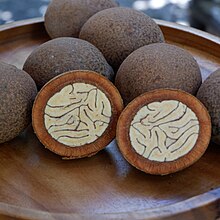
Breadfruit is a species of flowering tree in the mulberry and jackfruit family (Moraceae) believed to be a domesticated descendant of Artocarpus camansi originating in New Guinea, the Maluku Islands, and the Philippines. It was initially spread to Oceania via the Austronesian expansion. It was further spread to other tropical regions of the world during the Colonial Era. British and French navigators introduced a few Polynesian seedless varieties to Caribbean islands during the late 18th century. Today it is grown in 90 countries throughout South and Southeast Asia, the Pacific Ocean, the Caribbean, Central America and Africa. Its name is derived from the texture of the moderately ripe fruit when cooked, similar to freshly baked bread and having a potato-like flavor.

Calamansi, also known as calamondin, Philippine lime, or Philippine lemon, is a citrus hybrid cultivated predominantly in the Philippines. It is native to the Philippines, parts of Indonesia, Malaysia, and Brunei, as well as parts of southern China and Taiwan.

Carambola, also known as star fruit, is the fruit of Averrhoa carambola, a species of tree native to tropical Southeast Asia. The edible fruit has distinctive ridges running down its sides. When cut in cross-section, it resembles a star, giving it the name of star fruit. The entire fruit is edible, usually raw, and may be cooked or made into relishes, preserves, garnish, and juices. It is commonly consumed in Southeast Asia, South Asia, the South Pacific, Micronesia, parts of East Asia, the United States, parts of Latin America, and the Caribbean. The tree is cultivated throughout tropical areas of the world.

The jackfruit is a species of tree in the fig, mulberry, and breadfruit family (Moraceae). The jackfruit is the largest tree fruit, reaching as much as 55 kg in weight, 90 cm in length, and 50 cm (20 in) in diameter. A mature jackfruit tree produces some 200 fruits per year, with older trees bearing up to 500 fruits in a year. The jackfruit is a multiple fruit composed of hundreds to thousands of individual flowers, and the fleshy petals of the unripe fruit are eaten.
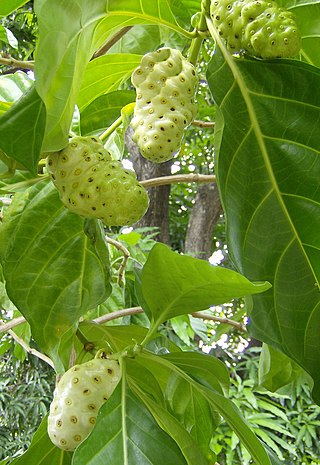
Morinda citrifolia is a fruit-bearing tree in the coffee family, Rubiaceae, native to Southeast Asia and Australasia, which was spread across the Pacific by Polynesian sailors. The species is now cultivated throughout the tropics and widely naturalised. There are over 100 names for this fruit across different regions, including great morinda, Indian mulberry, noni, beach mulberry, vomit fruit, awl tree, and rotten cheese fruit.
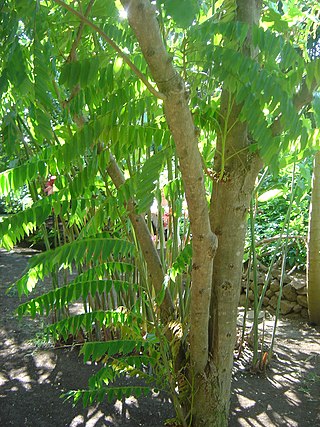
Averrhoa bilimbi is a fruit-bearing tree of the genus Averrhoa, family Oxalidaceae. It is believed to be originally native to the Maluku Islands of Indonesia but has naturalized and is common throughout Southeast Asia. It is cultivated in parts of tropical South Asia and the Americas. It bears edible but extremely sour fruits. It is a close relative of the carambola tree.

Filipino cuisine is composed of the cuisines of more than a hundred distinct ethnolinguistic groups found throughout the Philippine archipelago. A majority of mainstream Filipino dishes that comprise Filipino cuisine are from the food traditions of various ethnolinguistic groups and tribes of the archipelago, including the Ilocano, Pangasinan, Kapampangan, Tagalog, Bicolano, Visayan, Chavacano, and Maranao ethnolinguistic groups. The dishes associated with these groups evolved over the centuries from a largely indigenous base shared with maritime Southeast Asia with varied influences from Chinese, Spanish, and American cuisines, in line with the major waves of influence that had enriched the cultures of the archipelago, and adapted using indigenous ingredients to meet local preferences.
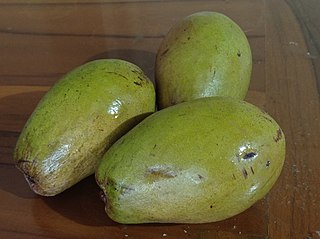
Mangifera caesia is a species of flowering plant in the cashew family, Anacardiaceae. Known in English as jack or white mango, among other names. It belongs to the same genus as the mango and is widely cultivated in areas of Indonesia, Malaysia, Singapore, Brunei, Papua New Guinea and the Philippines.

Heritiera littoralis, commonly known as the looking-glass mangrove or tulip mangrove, is a mangrove tree in the family Malvaceae native to coastal areas of eastern Africa, Asia, Melanesia and northern Australia. The common name refers to the silvery appearance of the underside of the leaves, resembling a mirror to some degree. The strong timber has uses in marine applications and elsewhere.
Atuna cordata is a tree in the Atuna genus of the family Chrysobalanaceae. The specific epithet cordata is from the Latin meaning "heart-shaped", referring to the leaf base.

Kinilaw is a raw seafood dish and preparation method native to the Philippines. It is more accurately a cooking process that relies on vinegar and acidic fruit juices to denature the ingredients, rather than a dish, as it can also be used to prepare meat and vegetables. Kinilaw dishes are usually eaten as appetizers before a meal, or as finger food with alcoholic drinks. Kinilaw is also sometimes called kilawin, especially in the northern Philippines, but the term kilawin more commonly applies to a similar lightly grilled meat dish.

Antidesma bunius is a species of fruit tree in the family Phyllanthaceae. It is native to South Asia, Southeast Asia, Melanesia, and northern Australia. It is commonly known as bignay, after its native name in the Philippines, where the fruits are commonly used for making bignay wine and jams. It is also known more ambiguously as Chinese laurel, Queensland cherry, salamander tree, wild cherry, and currant tree.

Sambucus racemosa is a species of elderberry known by the common names red elderberry and red-berried elder.

ʻOta ʻika is a Oceanian dish consisting of raw fish marinated in citrus juice and coconut milk. The Tongan, Tahitian, and Samoan variants are essentially identical in that the raw fish is briefly marinated in lemon or lime juice until the surface of the flesh becomes opaque. The fish is then mixed with coconut milk and diced vegetables. This is the national dish of Tonga.

Hinava is a traditional native dish of the Kadazan-Dusun people in the state of Sabah. It is made from fish and mixed with lime juice, bird's eye chili, sliced shallots and grated ginger. While the Kadazan are famous with their Hinava tongii.
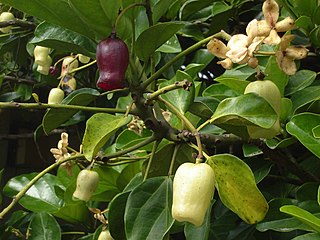
Atuna racemosa subsp. racemosa is a subspecies of Atuna racemosa, a plant species in the family Chrysobalanaceae.
Atuna nannodes is a tree in the family Chrysobalanaceae. The specific epithet nannodes is from the Greek meaning 'dwarf', referring to the tree's small size.

Spondias pinnata, sometimes also known as hog plum, is a species of tree with edible sour fruits. It is native to the Philippines and Indonesia, but has been widely naturalized in South Asia, Mainland Southeast Asia, Southern China, and the Solomon Islands. It belongs to the family Anacardiaceae. This species, among several others, has sometimes been called the "wild mango" in other languages and was once placed in the genus Mangifera. It is found in lowlands and hill forests up to 1,200 m (3,900 ft).
Atuna excelsa is a species of flowering plant in the family Chrysobalanaceae, native to Thailand to the western Pacific.

